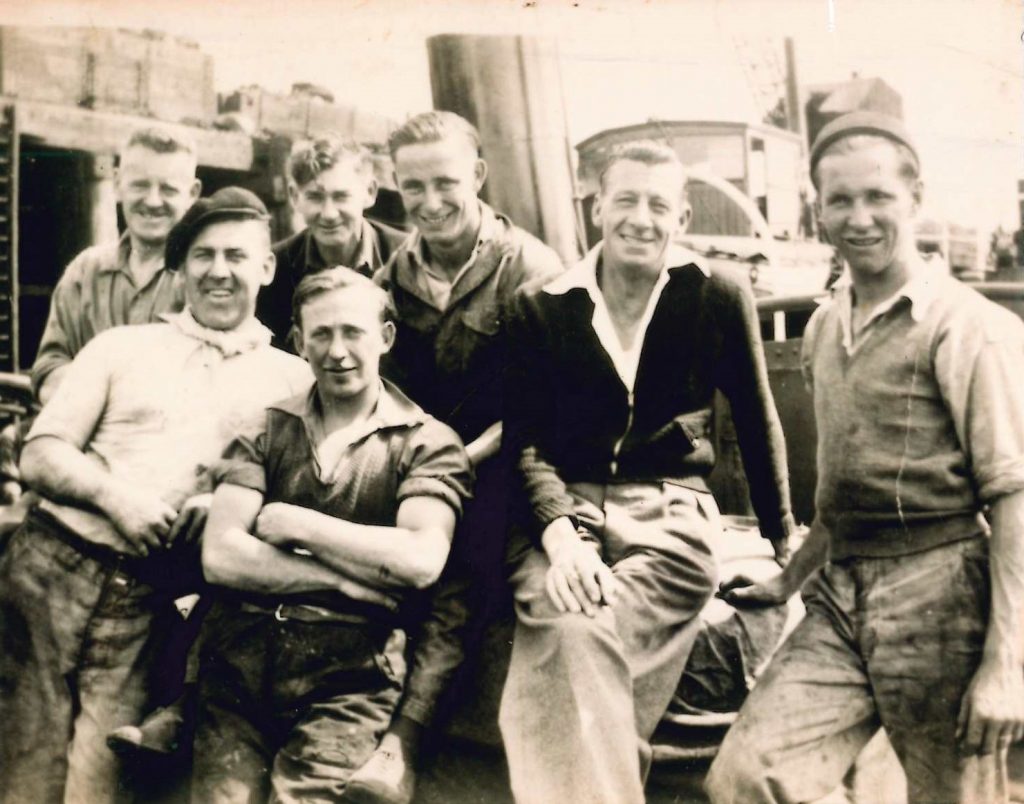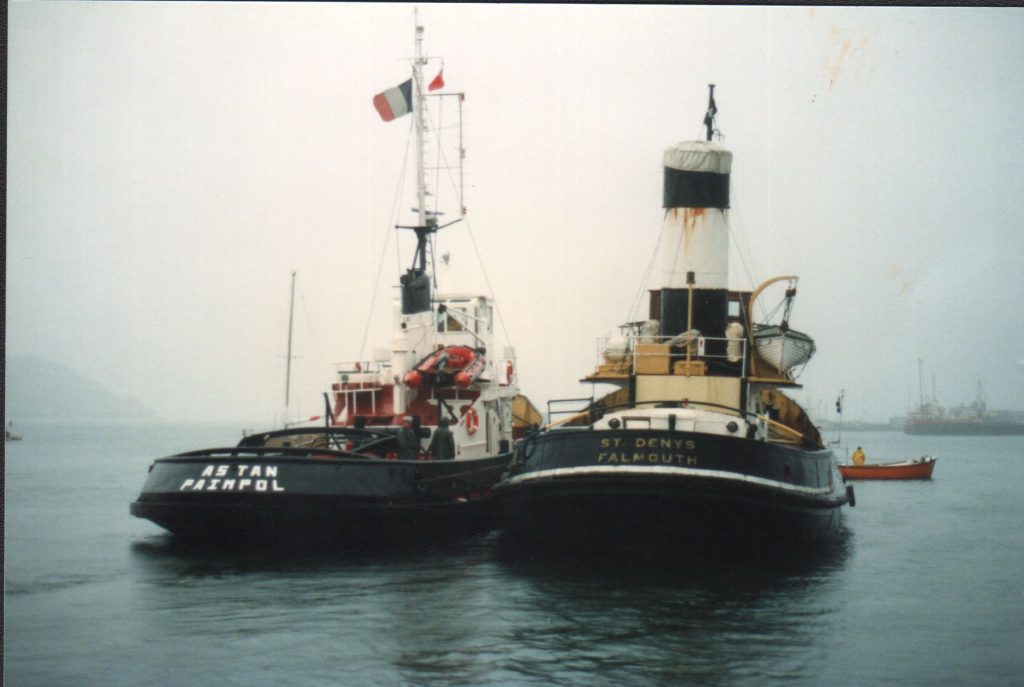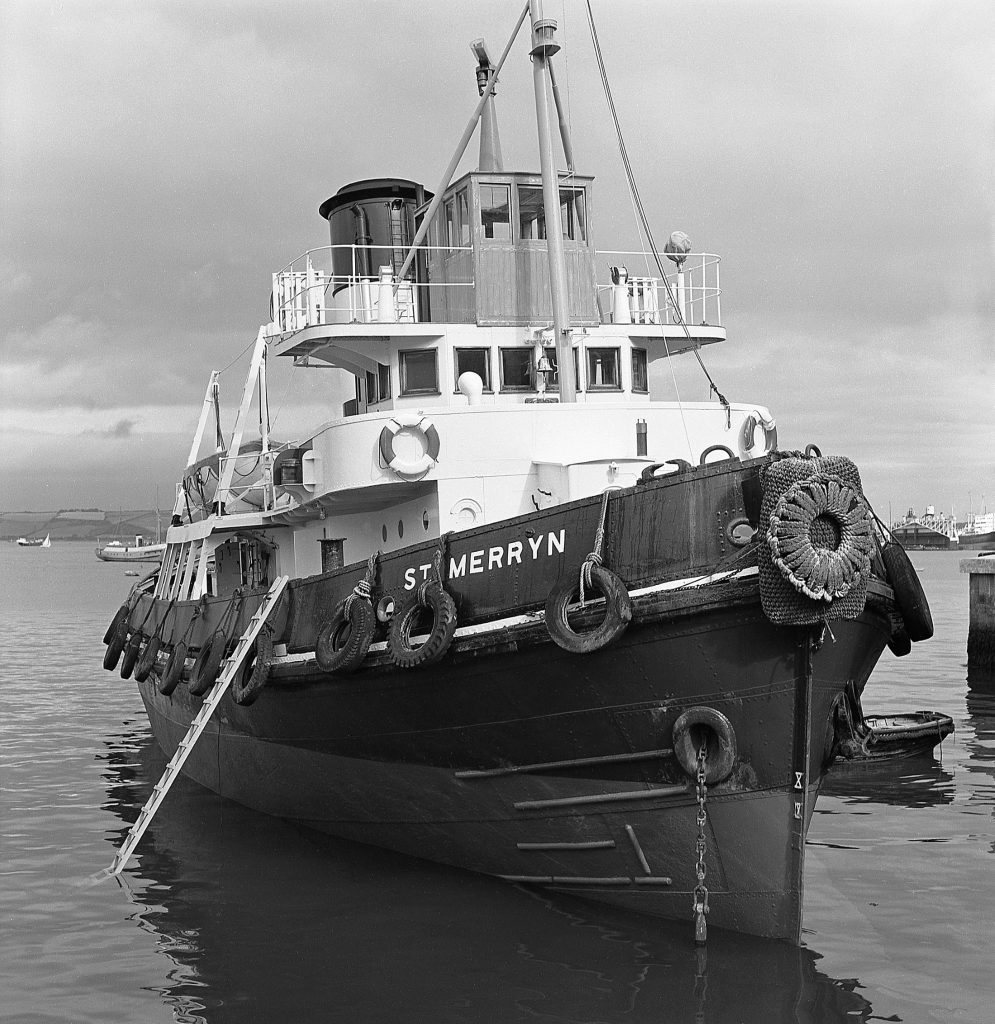

By Lynne Vosper
The Falmouth Towage Company celebrated 130 years in the towage business during May 2023, and was established to provide towage support to Falmouth Bay, Carrick Roads, Port of Falmouth, and Port of Truro.
This blog will show some of the photographs from the National Maritime Museum Cornwall’s archive collections of the seven Falmouth steam tugs that operated in Falmouth Harbour from 1925 until 1984 and were an integral part of the busy working life of the harbour.

Falmouth Harbour steam tugs, known as ‘The Magnificent Seven’, L-R St Mawes, Lynch, St Merryn, St Levan, St Eval, St Denys and St Agnes, c1955.
In later years, the Falmouth Towage Company re-used the names of three of the above tugs and they are not to be confused with the famous ‘Magnificent Seven’. They were the second St Eval, ex-Chieftain which arrived in 1967, the second St Agnes, ex-Warrior which came to Falmouth in 1968, and the second St Mawes, ex-Ionia which arrived in 1988.

Five of the Falmouth steam tugs, St Levan, St Denys, St Mawes, Lynch and St Merryn at anchor in Falmouth Harbour. Photograph taken during September 1964. Weller Collection ©NMMC.
The above image shows five of the Falmouth Towage Company fleet of seven steam tugs, the St Levan, St Denys, St Mawes, Lynch and St Merryn at anchor in Falmouth Harbour during August 1964. Together with the St Eval and St Agnes, they were affectionately known as the “Magnificent Seven”, with their distinctive black and white funnels, green hulls, and varnished wheelhouses.
Each tug had a crew of seven men consisting of a master, mate, chief and second engineers, fireman and two deckhands, with the St Mawes having an extra deck hand for maintenance and coastal towing services.
The Lynch was launched in Holland in 1924 as Foremost 23, and was built by J. Meijer’s Scheepsbouw Mij, Zaltbommel, for her first owners James Dredging Towing and Transport Co Ltd, Southampton. In 1925 the 211-gross ton tug was purchased by the Falmouth Docks and Engineering Company and renamed Lynch and in 1931 was sold to the Falmouth Towage Company. During the Second World War, Lynch was commandeered by the Admiralty and was stationed at several ports, including London, Dover, Inverness and Cardiff. Renowned for her very high funnel she was the only tug not to take on a Saint’s name when the Falmouth fleet was renamed.

The Falmouth Towage Company tug Lynch alongside North Quay with flag flying at half-mast is on a funeral service mission as there is a Minister on deck starboard side. Taken during August 1957. Weller Collection ©NMMC

Letter regarding the naming of Lynch from a copy of ‘Full Ahead ‘ held at the Bartlett Maritime Research Centre and Library, NMMC.
On 30 May 1953, the Lynch was assisting with the berthing of BP Tanker British Sailor when the ship’s propeller tore a hole in the port side of the tug. The Lynch sank in a few minutes, and was raised again on 17 June.

Entries in the Port of Falmouth Harbour Master’s Journal No. 32 regarding the sinking and raising of the Lynch in 1953. The Journals are held at the Bartlett Maritime Research Centre and Library, NMMC.

Lynch ended service in 1967 after 43 years in the port and was towed away by the tug Warrior in 1968 to be scrapped at Haulbowline breakers’ yard at Cobh, County Cork, Ireland.

Lynch and St Agnes alongside at Town Quay taken during October 1961. Weller Collection ©NMMC.
The tug St Denys holds a special place in the hearts of many of those who were involved with the Falmouth Docks. She was a steam tug, built at Dalmuir in Glasgow in 1929 by William Beardmore and Company Limited. She was owned firstly by the Falmouth Dock and Engineering Company in 1929 and from 1932 by the Falmouth Towage Company until 1982 and spent all her 52 years working life in the Port. As one of the tugs operating in Falmouth Harbour, she was a familiar sight to many. Originally called Northgate Scot, she was given the name St Denys in 1959 when the Falmouth tugs were named after Cornish Saints.

The maker’s nameplate. Image from the Bartlett Maritime Research Centre and Library Collection.

Steam tug Northgate Scot, later named St Denys, moored in Falmouth Harbour, taken in August 1957. Weller Collection ©NMMC

The crew of the Northgate Scot during the 1950s. Back row, left to right – Leslie Svenson, Ike Richards, Jack Beattie Front row, left to right – Glossy Andrews, Jack Harris, Capt. Wright, Roy Coote. Image from the Bartlett Maritime Research Centre and Library Collection.

St Denys moored in Falmouth Harbour. Roy Stribley Collection ©NMMC.
The St Denys was retired in 1980 when the cost of steaming her became prohibitive (some seven tons of fuel a day) and in 1981 the Falmouth Maritime Museum were delighted to announce the purchase to prevent her being sold for scrap. She was kept at Customs House Quay as a visitor attraction. The St Denys is unique in having the only Caprotti valve marine steam engine in existence. The overall length of the tug is 97 feet, and she has a beam of 25 feet. With a gross tonnage of 280 tons, she has a 790-horsepower triple expansion engine. Originally the St Denys had a coal fired boiler, but in 1963 this was changed to oil firing.
She was sold in 1991 and since 1992 can be visited at her new home, the Port Musee, Douarnenez in Brittany.

Falmouth tug St Denys moored as a museum tug in the Town Quay basin in Falmouth. Taken during October 1981. Weller Collection ©NMMC.

Falmouth tug St Denys leaving Custom House Quay with French tug Astan, on its journey to the Maritime Museum at Douarnenez in Brittany in 1991. Photograph from the Roy Stribley Collection ©NMMC.
The St Denys is the only surviving tug from the Magnificent Seven.

Image from website of Douarnenez Port Musee showing the ‘Saint Denys, steam tugboat’. www.port-musee.org
The caption for the image on the Port museum’s website:
“The Saint-Denys, built in Scotland in 1929, belonged to the Falmouth Towage Company. This company’s ships, easily recognizable due to their green hulls and black and white chimneys, drew attention with their robust, short, wide silhouettes.
The Saint-Denys is the only visitable steam tug in France, and notably boasts a 790 hp triple-expansion engine. In the 1950s, a period of intense port activity, the Falmouth tugs were used up to 14 times a day. This meant that 40 tonnes of coal had to be loaded every three weeks.
The Saint-Denys joined the Port Museum’s collection in 1992”.
The 226 gross ton steam tug Fairnilee was built by Cochrane & Sons Ltd of Selby who built trawlers for the Hull and Grimsby fishing fleets, coasters and tugs.
Built in 1925 for United Towing Company Limited of Hull she was originally called Nobleman, Yard No. 980. The keel was laid in January 1925, she was launched on 7 July 1925 and completed in November 1925. The 800-horsepower engine was by Earles Shipping and Engineering Co Ltd.
On 7 September 1937 the tug was sold to Falmouth Towage Company and renamed Fairnilee. She was renamed yet again in 1959 as St Agnes.

Entry in Port of Falmouth Harbour Master’s Journal No. 26 recording damage to Fairnilee and Northscot Scot during an air raid in Falmouth on 29 January 1942.
The St Agnes left Falmouth in 1968 together with the Lynch to be scrapped at Haulbowline breaker’s yard, Cobh, County Cork, Ireland where breaking up commenced in November 1968.

Fairnilee, later named St Agnes, in Falmouth Harbour with tug Lynch behind her. Taken during August 1956. Weller Collection ©NMMC

St Agnes in Falmouth Harbour during October 1961. Weller Collection ©NMMC

Tugs Fairnilee, later renamed St Agnes, Arusha, later renamed St Mawes, and Lynch, at anchor in Falmouth Harbour. Taken during 1958 or 1959. Weller Collection ©NMMC
With 80,000-ton dwt tankers expected to use the Port of Falmouth after the construction of number 2 dry dock and the County and Duchy wharves, docks management decided to invest in new towage assets. The 346 gross tons, 700-horsepower Arusha, built in 1951 by Henry Rodd Ltd at Leith, and later to be renamed St Mawes, was purchased from the British India Steam Navigation Company in 1956. Under the command of Captain EG “Ted” Newton, a local crew comprised of Falmouth Towage Company hands brought the tug back to Falmouth from Mombasa.

Drawing of Arusha in ‘British Steam Tugs’ by PN Thomas Copy held in the Bartlett Maritime Research Centre and Library.

Falmouth Tug Arusha, later St Mawes alongside at Town Quay. Taken during August 1957. Weller Collection ©NMMC.
The St Mawes was one of the steam-powered Falmouth tugs known as ‘The Magnificent Seven’. She ended her service in Falmouth in 1983 and was towed away in January 1984 together with the St Merryn bound for the scrapyard at Ouwerkerk in Holland.

Falmouth Tug St Mawes in Falmouth Harbour. Taken during October 1961. Weller Collection ©NMMC

Falmouth Tug St Mawes passing Black Rock. Roy Stribley Collection ©NMMC.
Launched as the Rock Pigeon in 1945, this 233-ton steam tug was ordered by the Admiralty and was paid for and built under the direction of the Canadian Government by the Canadian Shipbuilding and Engineering Company of Ontario. She worked at Hong Kong and then Singapore where she was renamed Flaunt in 1948. She was purchased by Falmouth Towage Company in 1959 and given the local name St Merryn. At 1000-horsepower, the St Merryn was the most powerful of the Magnificent Seven.
Crew members from the Falmouth Towage Company brought back the tug Flaunt from Hong Kong in 1959 with Captain Edward Newton. They flew out by Comet and spent three weeks in Hong Kong before returning via Singapore, Bombay, the Suez Canal, Algiers and Gibraltar.

St Merryn approaching the Town Quay in Falmouth Harbour during September 1964. Weller Collection ©NMMC

St Merryn in Falmouth Harbour, probably beached for routine maintenance. Taken between 1967 and 1969. Weller Collection ©NMMC
The St Merryn was replaced by a motor tug and was towed out of Falmouth with the St Mawes when they were both sold to a Dutch shipbreaker in Ouwerkerk in January 1984.
The St Levan, ex-Codicote Scot, and formerly German tug Bruno Dreyer, was built as barge tug in 1942 and arrived in Falmouth in 1959. At 160 gross tons the 700-horsepower oil-fuel steam tug was the smallest of the fleet of harbour tugs used for moving ships in and out of the shipyard.

Codicote Scot, later St Levan in Falmouth Harbour. Taken in August 1957. Weller Collection ©NMMC

Codicote Scot, later St Levan in Falmouth Harbour. Roy Stribley Collection ©NMMC

Falmouth tug St Levan with St Mawes Castle in the background. Roy Stribley Collection ©NMMC
On 16 February 1960, The St Levan sank at Falmouth Docks when she got into difficulties while towing the tanker British Justice from the docks to the outer harbour. The crew of a French deep-sea trawler alongside Falmouth Docks saw what was happening and launched a ship’s lifeboat. The skipper and crew of six, all Falmouth men, were rescued unharmed and landed at the docks. The tug was refloated and brought back into service.
The St Levan was scrapped in 1972 and taken to Bilbao, Spain.

Norgrove, later St Eval, in Falmouth Harbour. Photograph taken from the St Mawes Ferry during August 1956. Weller Collection ©NMMC.
This 227 gross ton tug was built in 1910 by Philip and Son of Dartmouth, was launched on 26 March 1910 and completed on 20 June 1910. Her engine was built by Earle’s Shipbuilding and Engineering Company of Hull. She was delivered to her first owner, Tilbury Contracting & Dredging Co Ltd and named Danube. During 1914 she was requisitioned for war duties by the Admiralty and returned to the Thames in 1920 and renamed Danube II. In 1935 she was sold to Falmouth Docks and Engineering Company and renamed Norgrove. She was requisitioned by the Admiralty for a second time for harbour duties from 23.12.1941 to 7.7.1945, then returned to her owner. In 1959 her owners became Falmouth Towage Company Limited, and she was renamed St Eval.
During 1962 the St Eval was sold to TW Ward Limited of Sheffield and on 29 November 1962 she arrived at Briton Ferry, South Wales for demolition.

St Eval, alongside Town Quay during October 1961. Weller Collection ©NMMC.

Crew members of the Falmouth Tugs. Photograph taken c1970 on board the tug St Mawes on her moorings in Falmouth Harbour.
Standing on the left of the photograph is Russell Hughes
Back row, left to right: Barry Morris, Kenny Pond, Billy Sweet, Ivor Martin, Tom Adamson, Ernie Beattie, Mike Tuffery, Charlie Hardenstein, Dave Richardson
Front row, left to right: John Tuffery, Dennis Nicholls, Dave Michell, Paddy Terry, Jimmy Holsten, Tony Sweet, Alan Jones, Terry Roberts, Robert Trevaskis, Eric Martin (Thank you to Alan Jones, David Proud, Dave Richardson and David Angove who helped to name the men in this photograph).
This Bartlett Blog has been written using information held at the Bartlett Maritime Research Centre and Library and photographs from the NMMC archive collection.
The Bartlett Blog is written and produced by the volunteers who staff The Bartlett Maritime Research Centre and Library of National Maritime Museum Cornwall. This blog post was written by Lynne Vosper, a Bartlett Library volunteer.
The Bartlett Maritime Research Centre & Library holds a Collection of over 20,000 volumes and offers access to one of the finest collections of maritime reference books, periodicals and archival material. The Bartlett Blog reflects the diversity of material available in The Bartlett Library.

National Maritime
Museum Cornwall Trust
Discovery Quay
Falmouth Cornwall
TR11 3QY
View Map
See our opening hours
Tel: +44(0)1326 313388
Email: enquiries@nmmc.co.uk